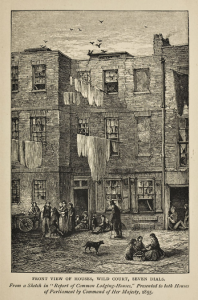So much of London’s history involves a series of adaptations to shifting environments over time that poets have remarked the only constant in London is change. This is no less true for the metropolitan St. Giles District of London during the 19th century. Beginning with a workhouse and a hospital for poor married women in the period of 1801-1810, the district was already concerned with serving the poor in the area. This concern only expanded as time went by.
Three decades later more charitable institutions are added: two refuges for destitute boys and an association for improving the housing conditions of the poor. The refuges for the destitute boys gave the children basic necessities such as food and clothing. The children were also put to work; they could learn trades like shoemaking, tailoring clothes, and housework, or get sent to a farm, the American colonies, or training ships to learn their trades. Twenty years later a girl’s refuge was open as well, but closed by 1881. Here, girls were also trained for jobs, but instead as laundrywomen and house servants. It’s difficult to say why there were more refuges for boys than girls, however, one may speculate that the refuges may have derived much of their income from training children for trades, therefore, valued boys more than girls given the wider variety of trades available to males. The creation of these additional institutions showed how poverty increased in the district over time. As children who lived in poverty couldn’t be supported by their families either due to their being deceased or an inability to find adequate work, these refuges were their only option. The need for the association relating to housing conditions was also very telling of the poverty in this district. Housing security remained a large concern as slums were demolished and the poor evicted, hence the continued existence of this association up to 1890 and possibly beyond.

Beginning in 1875, new charities began to enter the scene. Missionaries came to serve the poor in lodging house kitchens. In the next decade, when the missionaries and the girls’ refuge had left, an orphanage and almshouse were added to the district. In this way, the number of charitable organizations increased or remained the same as the century progressed. Moreover, the concerns of the organizations also remained the same: to house the poor and to take care of the children. The new organizations simply did this work in different ways. While the refuges were gendered and oriented around teaching children a trade, the orphanage was open to any child who had lost a father or both parents and provided an education in addition to basic necessities.
